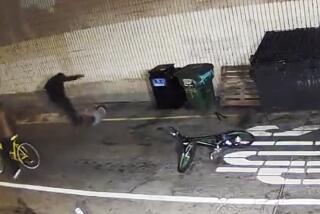The Cleveland killer wasn’t the first to post a gruesome crime. Welcome to the dark side of sharing
- Share via
Four assailants tied up an 18-year-old mentally disabled man, taped his mouth and slashed at his scalp with a knife as he cowered in a corner.
A group of men and boys dragged a 15-year-old girl to a bed and raped her.
Both crimes — and others like them — were captured on video and widely viewed on the Internet, which in the age of smartphones and security cameras is not surprising. What made this footage different is that it was shot and posted by the criminals.
They are part of a trend that played out again this week with a killing that captivated the nation: a 74-year-old man in Cleveland was shot by a 37-year-old stranger named Steve Stephens, whose videos first posted on Facebook found an audience of millions.
The crimes have played out like grim reality television — on occasion in real time — with ordinary people becoming unwitting publicists for criminals and social media companies forced to confront the moral implications of offering the world a blank canvas.
That criminals sometimes seek publicity is nothing new. The assailant known as the Zodiac Killer wrote letters to newspapers during a killing spree in the San Francisco Bay Area in the late 1960s and early 1970s.
But as technology has advanced, it has been easier for criminals to have their voices heard, said Elizabeth Joh, a law professor at UC Davis.
“This is absolutely the dark side of providing an open, live forum for someone to post whatever they want,” she said.
Facebook Chief Executive Mark Zuckerberg responded to the Cleveland killing on Tuesday, telling a conference of developers in San Jose: “We have a lot more to do here.”
“We will keep doing all we can to prevent tragedies like this from happening,” he said.
In Moneta, Va., in 2015, a gunman killed two television journalists during a live broadcast, then apparently posted video on Facebook and Twitter showing the shooting from his perspective.
In Columbus, Ohio, last year, an 18-year-old woman broadcast the rape of her friend on the livestream app Periscope — reportedly while giggling.
In Chicago, at least four violent crimes have been broadcast on Facebook Live since October, including the gang rape of a 15-year-old girl last month and the assault of the mentally disabled man in January.
As many as 40 people watched the rape as it was happening, authorities said. No one called the police.
“It just disgusts me that people could look at those videos and not pick up the phone and dial 911,” Chicago Police Supt. Eddie Johnson told reporters after the attack. “It makes you wonder where are we going, what are we doing as a society?”
The trend is not confined to the U.S. In Sweden this year, police arrested three men suspected of raping a woman while broadcasting it to a group on Facebook.
In Cleveland, Stephens made sure his video recording device was rolling as he approached his victim, Robert Godwin Sr.
“Found somebody I’m about to kill,” he said.
Stephens struck up a brief conversation before he lifted a black handgun and fired a single round into Godwin’s face as blood splattered on the sidewalk.
Then Stephens walked back to his car and drove off.
It is unclear when the attack occurred. But according to a timeline released by Facebook, Stephens uploaded a video in which he declared his intent to commit murder at 11:09 a.m. Sunday. No users flagged it, so it did not come to the attention of the company.
Two minutes later, Stephens posted the video of Godwin’s slaying.
At 11:22 a.m., Stephens went on Facebook Live for five minutes and broadcast himself speaking to someone on his cellphone and saying, “I snapped. Dog, I just snapped…. I killed 13 people. And I’m about to keep killing until they catch me.”
The livestream was reported to Facebook shortly after it ended. But the company says it was not notified about the shooting video until 12:59 p.m. Stephens’ account was disabled 23 minutes later. The video had been up for more than two hours.
The shooting prompted a nationwide manhunt that ended Tuesday when authorities closed in on Stephens in Erie, Pa., after he was spotted ordering Chicken McNuggets and fries at a McDonald’s.
He led police on a brief chase before he turned his gun on himself, but not before millions of people had watched his videos, even as the victim’s family implored them not to.
Many people expressed regret about watching the footage, which some social-media users posted on Twitter. “Unfortunately watched the #Cleveland shooting video,” one user named Adel tweeted as a warning. “Just don’t.”
“I didn’t realize what I was watching till it was too late,” somebody responded.
A user named Samuel wrote that watching the footage was like watching a violent Hollywood movie. “I’ve seen a lot of killing scenes in movies and shows but knowing this one is real, my heart jumped and then sank,” he tweeted.
In the aftermath of the killing, some experts have drawn comparisons to the notorious case of Kitty Genovese, who was stabbed to death in 1964 as she screamed for help outside her apartment in Queens, N.Y. The case became a symbol of public indifference, though some parts of the story have been debunked.
One neighbor remembered calling the police but was told by a clerk that authorities were aware of the attack, according to a documentary produced decades later.
Experts said the people who watched the Cleveland killing or other crimes broadcast online can’t necessarily be faulted for failing to act.
“People are so used to hoaxes and … fiction online that their first reaction, depending on the circumstances, may well be, ‘This is a joke,’ ” said UCLA law professor Eugene Volokh.
They may also assume someone else has already called police. “When you see an accident on the side of the street, sometimes you call 911,” he said. “Sometimes you say, ‘Someone called 911 already.’ ”
The videos may also serve a useful purpose: to help solve and prosecute crimes.
“This is evidence, and it is evidence in plain sight,” said Tod Burke, a former Maryland police officer and now a criminal justice professor at Radford University. “You want to bring someone to justice, what better way to do it than have the evidence produced, directed and starred in by that individual?”
Times staff writer Matt Pearce contributed to this report.
Follow me on Twitter @AleneTchek
ALSO
Hate crime is suspected after a gunman kills 3 white men in downtown Fresno
California bill would make it harder to punish police officers who have been accused of lying
‘Dreamer,’ 23, sues after he is deported by Trump administration
More to Read
Sign up for Essential California
The most important California stories and recommendations in your inbox every morning.
You may occasionally receive promotional content from the Los Angeles Times.












